Este post também está disponível em:
Português
English
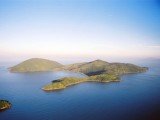
Anchieta Island is one of the main tourist attractions of Ubatuba, both for its historical importance with the Ruins of the Prison, for the beautiful beaches and trails, for the excellent diving spots and for the Atlantic Forest preserved by the Anchieta Island State Park.
Being very close to the mainland, access is easy by boats, speedboats and schooners.
Anchieta Island is the second largest island on the coast of São Paulo (828 hectares) and one of the main tourist attractions of the Municipality of Ubatuba.
Protected by the creation of the Anchieta Island State Park, it presents visitors with a great spectacle of nature.
On the island we also find a bit of the history of Brazil. Inhabited by Indians until the beginning of the 19th century, it was known at that time as the Land of Cunhambebe, who was the head of the Tamoios Confederation.
Baptized by the colonizers as Ilha dos Porcos, in 1904 a correctional colony was installed there, later becoming a political prison.
In 1955, after intense prison riots, the prison was deactivated.
The name of the island was changed to Anchieta Island in 1934, as part of the tributes to the fourth centenary of the birth of Father José de Anchieta.
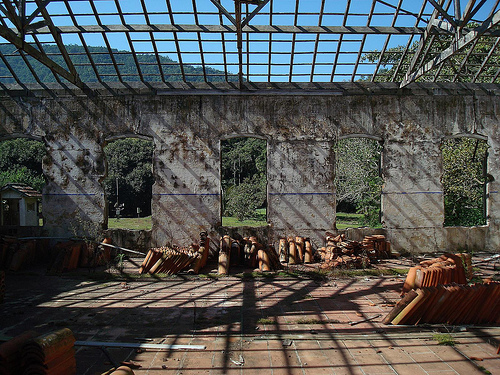
Ilha Anchieta SP
The island was practically abandoned until March 29, 1977, when the Anchieta Island State Park was created, today integrated into the network of Conservation Units managed by the São Paulo Environment Secretariat through the Forestry Institute.

The Park occupies the entire Anchieta Island and, in addition to protecting the natural wealth, preserves the rich historical and cultural heritage represented by the ruins of the prison and its facilities.
Anchieta Island is one of the most popular places for tourists in Ubatuba.
It provides the beautiful visual of the Atlantic Forest that makes up its vegetation, beautiful beaches, ecological trails, tours through the ruins of the old prison and one of the best spots for diving in Brazil.
History of Anchieta Island
Soon after the discovery of Brazil, around 1,550, Anchieta Island was inhabited by the Tamoios and Tupinambás Indians. They called the island Tapira, translated as “quiet place”.
The Tupinambás had as their great leader the chief Cunhambebe.
He is an extremely important character, because at that time there were several conflicts and the Portuguese colonizers. The Jesuit missionaries José de Anchieta and Manoel da Nóbrega achieved a friendly approach with Cunhambebe, which resulted in the famous Peace Treaty of Iperoig, signed on September 14, 1563.
From then on, the Portuguese could have more tranquility for the occupation of the colony.
The occupation of the island was then initiated, not only by Portuguese but also by Dutch, French and other Europeans. They lived basically from fishing and agriculture. Gradually, the settlement of the island was developing, gaining a small church, seeing small businesses grow and even a cemetery was built.
In 1885, the island was renamed Freguesia do Senhor Bom Jesus da Ilha dos Porcos.
In 1902 the island was better known as Ilha dos Porcos, when a penal colony was built on it. For this purpose, about 412 families were expropriated.
This colony would be deactivated in 1914, with prisoners being transferred to prisons in Taubaté; but in 1928 it was reactivated and to house political prisoners from the period of the Getúlio Vargas dictatorship.
At this time, in addition to the original inhabitants, soldiers and their families began to live on the island.
Ilha dos Porcos was renamed Ilha Anchieta in 1934 as part of the tributes to the fourth centenary of the birth of Father José de Anchieta.
In 1942 the former penal colony became the Correctional Institute of Anchieta Island.
The cells were built to form a rectangular courtyard. It was in this courtyard that the prisoners gathered, with cells around them where about 453 prisoners were confined, all of them highly dangerous.
There was a lot of animosity between rival groups, who fought each other in the courtyard, and the 50 or so police officers had a hard time containing these conflicts. The main leader of the prisoners was the dangerous João Pereira Lima, or Pernambuco.
One day Álvaro da Conceição Carvalho Farto, the famous Portuga, a criminal but also an engineering graduate and very intelligent, arrived at the prison to serve his sentence.
Little by little Portuga began to influence the other prisoners, structuring everyone’s life by giving specific functions to each one to organize internal life, which reduced conflicts.
But Portuga’s intentions were not exactly that. Having created an organization among the prisoners, he began to plan a rebellion, which included taking over the prison and the weapons that were kept in the barracks of Morro do Papagaio.
Under Portuga’s influence, the inmates became more cordial and gentle, and became very close to the police and even to the population of the island, in a climate of trust and peace that was actually the preparation for the coup.
The plan was executed in 1952 in a bloody battle between prisoners and police.
But one soldier managed to swim to the mainland and alerted the authorities. Several garrisons moved to the island to contain the rebellion. 129 prisoners were recaptured; some may have escaped in canoes.
Others tried to flee in boats, but their navigation skills caused them to fall into the water and be at the mercy of sharks. The great leader, Portuga, had heart problems and was found dead on the island.
Nowadays, Anchieta Island has totally changed its profile, having its fauna, flora and historical riches protected by the Anchieta Island State Park.
At the park’s headquarters, we find lots of information and photographic panels, tourism monitors for ecological and cultural trails, and the small chapel has been restored.
The facilities of the old prison, in ruins, attract the public to live the atmosphere where important facts for our history happened. And besides tourists, divers, researchers and other scholars seek Anchieta Island throughout the year.
Anchieta Island Beaches
Praia do Presídio
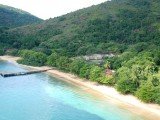
Main beach of the Anchieta Island State Park. Here, in the midst of its enchanting beauty, you can relive the history of the island, eternalized by the ruins of the prison erected on its sands at the beginning of this century, to detain political prisoners.
It is on Praia do Presídio, therefore, that you will find the facilities of the former penal colony (deactivated in 1955, when it detained common criminals, after a bloody rebellion), the administration of the Park with mooring and a base of the Tamar Project.
Its clear and calm waters are suitable for receiving the most varied vessels bringing visitors and researchers.
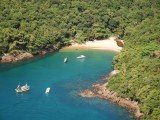
Praia do Leste
Small beach with clear waters, good for swimming and diving. Here, as in the whole island, you have the opportunity to enjoy the quiet of nature.
Access can be made by trails from Praia Grande and Praia do Presídio.
Praia do Sul
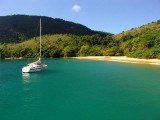
With clear waters of great visibility, this beach is chosen by fans of ecological tourism and diving. Its virgin nature can be visited by tours made by schooners that leave from Saco da Ribeira and Itaguá.
As it is located in the Anchieta Island State Park, this beach is preserved by state laws that prevent any kind of hunting or fishing, but only the beauty it offers is worth the ride.
It also has a trail that leads to Praia do Presídio.

Praia Grande
For those seeking tranquility, Praia Grande is a great option. Its clear sands, clear waters and wild Atlantic Forest make up a beautiful natural setting.
Beach of calm sea, allows the mooring of boats, a great option to enjoy nature.
Ruins of the Anchieta Island Prison
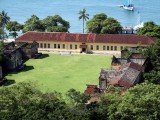
The Anchieta Island prison began to be built in 1902, when about 412 families of settlers and caiçaras who inhabited the place were expropriated. But in 1914 the Penal Colony was extinguished, and the inmates were transferred to Taubaté.
In 1928, the prison began operating again, this time mainly for political prisoners. Shortly afterwards the island, which was then called Ilha dos Porcos, was renamed Ilha Anchieta in honor of the Jesuit.
In 1942, with approximately 273 inmates, the Penal Colony was renamed the Correctional Institute of Anchieta Island, also receiving soldiers and their families as residents.
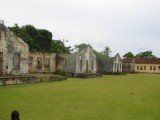
The deactivation of the prison occurred after the bloody rebellion of June 1952.
Today the buildings that were used by the prisoners and part of the structure of the prison are in ruins.
The site is preserved as a historical relic of Brazil, and tours are held there where trained monitors take tourists on a journey through an important chapter of Brazilian history.
Two recommended trails on Anchieta Island
Anchieta Island has trails that are an unmissable contact with the Atlantic Forest and its beautiful beaches. Upon disembarking on the island, tourists will find accredited monitors who accompany groups along these trails; they can only be traveled with their assistance.
Trilha do Saco Grande
The walk begins at the beach of the prison, through an area used for studies and research, and continues towards an old barracks where soldiers and civilians were killed in the 1952 rebellion. The vegetation is regenerating and occupying the houses of the old military village, bringing back the first residents of the forest.
At the end of the trail on the rocky coast we come across a viewpoint of the islands of the region and the open sea. On clear days it is possible to see sea turtles in their natural habitat. On the way back take a shower (Ducha do Maneco) reserved for those who take the tour.
Trilha da Praia do Sul
The path was once used by fishermen and local residents. Today the trail is documented with carrying capacity and interpretive points of the Atlantic Forest, restinga, legends, stories and great variety of fauna that is a source of study for the schools that visit the Park.
In the middle of the trail there is a viewpoint overlooking the entire Palmas cove.
When you arrive at the paradise beach, you will meet traditional fishermen. The southern beach with its crystal clear water and abundant marine life is an invitation to snorkeling.
Diving in Anchieta Island
Anchieta Island is considered one of the best diving spots in Brazil.
Protected by the Anchieta Island State Park, hunting and fishing are prohibited. However, contemplative diving is allowed, and the richness of the fauna, flora and large fish passing by allow a beautiful journey through the underwater world, much sought after by photographers for underwater photos.
The depth varies between 3 and 12 meters and the average water temperature is between 20°C and 28°C. In the summer there are often sharp drops in temperature, down to 15°C. Therefore, the use of 5mm isothermal clothing is recommended all year round. Visibility varies greatly depending on currents and weather conditions, ranging from 2 to 10 meters.
The bottom is composed of rocky shores and sand. Fauna and flora are abundant, and you can observe brain corals, sponges, algae, turtles, budgies, stingrays, groupers, whiting and colorful fish, especially at the South Point.
How to get to Anchieta Island
Anchieta Island is located on the North Coast of São Paulo, municipality of Ubatuba.
It is in front of Enseada Beach and Saco da Ribeira. To get to Anchieta Island tourists can opt for schooner rides that leave from Enseada and Saco da Ribeira pier, or rent a boat with crew.
To make the most of your trip, don’t forget to bring good walking shoes, sunscreen, insect repellent and a camera, as the island’s landscapes are unforgettable.
Anchieta Island Tourism and Travel Guide



















